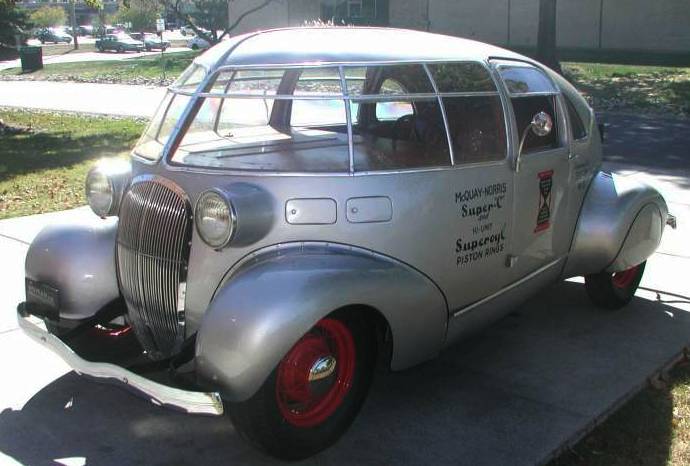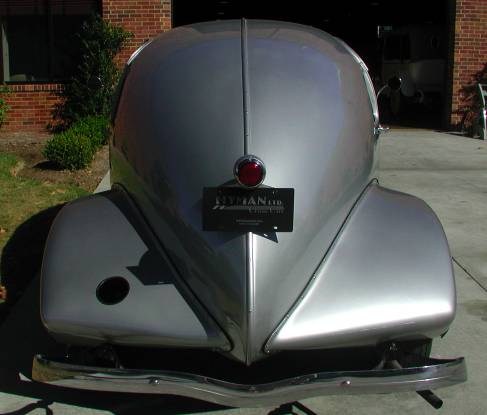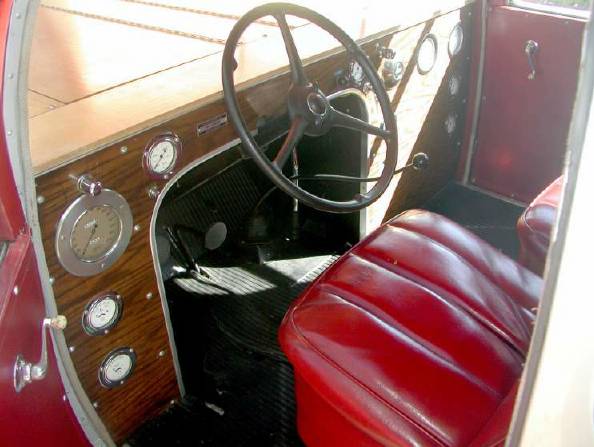|
créée
le 20 mars 2005 et mise à jour le 20 mars
2005
|

|
marque
|
McQUAY
NORRIS
|
|
modèle
|
STREAMLINER
|
|
finitions
|
cockpit sur
châssis Ford V8
|
|
année
|
1 9 3
4
|
|
quantité
/ prix
|
6 ou 15 selon la
source
|
|
carrosserie
|
monospace 2 portes 4
places
|
|
moteur/boite
|
V8 Ford
|
|
EXPOSITION DU
<<HYMAN SALES >> de SAINT LOUIS
(Missouri)
|

- hôte
: ce vendeur que je n'ai pas visité met de
temps en temps des véhicules exceptionnels
(celui-ci n'en fait pas partie) à vendre sur
e-bay
- voitures
américaines : il est plus
spécialisé dans les voitures anglaises,
surtout Austin et MG mais les américaines sont
présentes
- Photos
malheureusement petites de Hyman
|
- Here's
a scarce and little-known Oddie that today finds its home
in the Hemmings Motor News fleet, a 1934 McQuay-Norris
Streamliner. Bug-eyed, bulbous and ungainly looking,
these vehicles were not created in an attempt to break
any land-speed records, that's for sure. Instead, they
were intended as rolling test beds and promotional
vehicles for the McQuay-Norris Company of St. Louis,
which manufactured replacement pistons, rings, bearings
and other automotive bits and pieces that one might need
in order to rebuild an automobile engine or
chassis.
- The
idea to build the cars first came in 1932, and the task
fell to Cincinnati, Ohio's Hill Auto Body Metal Company,
which used unmodified 1932-33 Ford V-8 chassis and
engines as the basis for the six Streamliners. Bodies
were constructed of steel sheet metal attached to wood
framing, with the exception of the doors, which were
aluminum. In completed form, they very closely resembled
the one-off, Ford-powered 1932 Arrow Plane that Hill had
built for a wealthy Chicagoan. Notably absent from the
body design are rear windows and windshield wipers.
Reportedly, the company engineers who drove the
streamliners noted that the faster they drove, the more
visibility improved during rainy drives, as the water
rolled back thanks to the rounded Plexiglas front window
panes. Rearward visibility was handled by rear-view
mirrors mounted on either side. The McQuay-Norris rode on
General Jumbo Airwheels, which were much larger than the
stock Ford rolling stock, though the stock suspension
system was retained. In an interview in SIA # 14 with
author Robert J. Gottlieb, McQuay-Norris engineer George
E. Leutwiler related that, "These cars were easy to
drive, but they had some peculiarities. For instance, you
needed good shocks or the car would dance around a lot,
because of the donut tires. In those days most of the
roads were nothing but gravel. When I first drove from
St. Louis to Memphis and New Orleans, it was gravel all
the way, and that winter I did a few dances around curves
on gravel roads."
- As
noted before, there really wasn't any reason for the
aerodynamic teardrop styling other than to attract
attention, even though it did apparently help increase
the vehicle's top speed over the Ford cars that it was
based upon, and it is what was inside these unique
machines that mattered. All of the drivers were required
to rebuild the engine in their vehicle with McQuay-Norris
parts, thus providing adequate first-hand testimonials as
to the fitment of the parts. For reliability, the vehicle
itself provided proof of the durability of the
components. There were no less than fifteen different
gauges to monitor various aspects of the health of the
drivetrain. Most were housed in a large wooden bulkhead
that covered the engine in front of the driver; behind
the driver was a blow-by gauge that measured the levels
of unburned gases in the exhaust and acted as a wear
indicator for the piston/ring assemblies. Some of the
other gauges that provided relative analysis of the
performance of the McQuay-Norris components included
exhaust gas analyzer, viscometer, exhaust gas
temperature, compression, vacuum gauges along with more
common dial indicators for engine oil level, pressure and
temperature, water temperature and ammeter, and an
accuracy refined speedometer and odometer. That's only a
partial list, and that console must have been quite an
eyeful for the driver.
- The
drivers apparently kept copious records of all the
information that this instrumentation provided, which was
subsequently referenced during impromptu seminars held
when the Streamliners rolled into towns where there were
existing or potential distributors and users for its
product line. They were kept in operation until 1940,
then individually sold off. To date No. 9 (the
Streamliners were numbered up to 15) is the only one
known to have been found and restored to as close to
original condition as is possible. Its survival can be
credited to its purchase in 1973 by a British sports car
restorer, who then sold it to one Michael Schoen in 1975.
It was he who started its restoration. It took Schoen
fifteen years to get the Streamliner into an operable
condition. Hemmings acquired it nearly a decade later,
and it is still kept in driveable condition. It is used
for the occasional parade and displayed during Hemmings'
annual open house events, at which it draws more than its
fair share of attention.
- 1934 MCQUAY-
NORRIS STREAMLINER
- The
McQuay Norris Streamliner is an important piece of
automotive history. The car was one of six such cars
built by McQuay-Norris, a St. Louis based manufacturer of
internal engine and chassis components. The cars were
built using a 1934 Ford chassis and running gear and the
highly advanced streamlined body design was constructed
of steel and aluminum over a wood framework. The aircraft
inspired windshield and canopy design was constructed of
Plexiglas. The cars were built to be used by McQuay
Norris representatives for promotional purposes but more
importantly they used as test cars and as such they were
equipped with a multitude of gauges mounted to the dash
to monitor the performance of various components. It is
one of 2 such cars known to exist and the only one that
is restored. It was restored in 1990 and became part of
the Hemmings Motor News collection until purchased from
them.
- $149,500.00
|
|
PHOTOS DE LA
McQUAY NORRIS STREAMLINER 1934
|





des sites de
https://trombinoscar.com
![]()





![]()
![]()